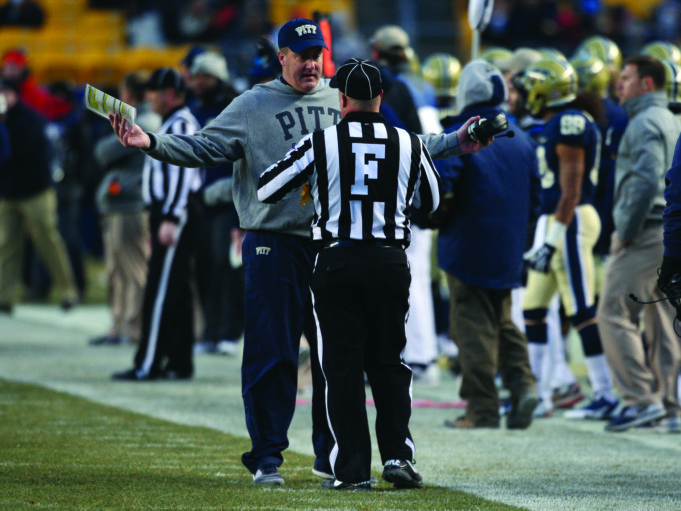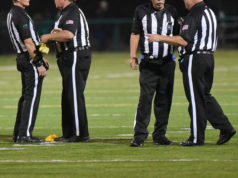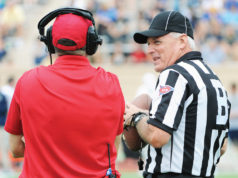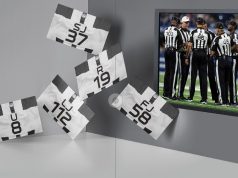Communication between officials and coaches is extremely important and is an essential element of a properly officiated game. Most coaches identify good communication as the single most important attribute of an official. There are limits, however. Being able to recognize when not to engage is as important as knowing what and when to have proper coach communications.
Allowed
The head coach is entitled to an explanation of all unusual rulings or situations. The emphasis is that communication is with the head coach only. A timeout is not charged for those types of discussions. Officials’ timeouts to talk to coaches outside of a coach-referee conference (NFHS 3-5- 2c; NCAA 3-3-4e) should seldom be allowed. The head coach may request the conference at any time while the ball is dead. The purpose of the rule is to review a possible misapplication of a rule by the officials, not to question a judgment call, nor to express an opinion on the quality of the calls. In NCAA play, a challenge may also be made if replay is available.
Additionally, a head coach may expect to have reasonable and brief questions answered by the wing official.
The head coach is entitled to the following information for all fouls:
- The nature of the foul (e.g. holding, personal foul, etc.).
- A brief description of the act.
- The number or position of the offending player.
- The enforcement and the result of the enforcement.
For example: “Coach, your number 62 was called for holding. He pulled down an opponent. The penalty is 10 yards from the spot of the foul and second down will be repeated.”
Referees should announce the number of the fouling player whether they have a microphone or not. That communication is important because it emphasizes the need for accuracy in calling fouls and deters phantom calls.
Under no circumstances should a number be fabricated. If that player wasn’t on the field (or worse yet, that number is not assigned), credibility has just been destroyed. Stating the offending player’s position instead of the number is acceptable, as in, “The motion man cut up too soon.” But, “Everybody but the center moved” may sound smart-alecky.
Not allowed
Assistant coaches and other authorized sideline personnel (athletic directors, chain crew, photographers, ball boys, athletic trainers, security personnel, etc.) are not entitled to any information from the officials. However, the wing official may opt to respond to simple, direct questions such as the number of the down or the number of timeouts remaining.
Coaches are not supposed to make any remarks regarding the officials’ behavior or judgment. They do not have an expressed or implied right to scream at or berate officials. Brief exclamations such as “Oh, no!” or “That wasn’t interference,” or requests like, “Can you watch for holding on number 65?” are acceptable, but comments such as, “They are holding on every play,” “Call it both ways,” “This is the worst officiated game I’ve ever seen,” etc., are not acceptable.
A warning (not a sideline warning) may be given for the first offense. Any subsequent violations should be treated as unsportsmanlike conduct.
Depending on the severity or harshness of the accusations, an unsportsmanlike foul or an ejection could be appropriate for a first offense. Warnings should not be given for any statement by anyone along the sideline that involves direct criticism of an official or an official’s decision. Those remarks usually include the word “You.” Such statements must result in an immediate unsportsmanlike conduct foul.
Any visual depiction of a foul such tugging on a shirt is an immediate foul. A team should not be penalized for actions by anyone for whom the head coach is not responsible (such as photographers). Simply ask the game administrator to remove the offender from the sideline.
Profanity
There is no clear consensus on the use of foul language. The rules prohibit profanity and vulgar language; however, opinions vary as to what words are vulgar or profane. Some will argue that “damn” is profane; others will find any word acceptable dependent on the context in which it is used. An example is the so-called F-bomb, which is one of the most versatile words in the English language. It serves as a noun, transitive verb, intransitive verb, adverb, adjective and exclamation. It is the latter form that may be very well ignored. A wide-open receiver who drops a pass and exclaims “Aw f- – -” might be excused by many officials. However, almost any other use of the word will elicit a flag.
In a recent game, a coach politely asked the line judge about a call made on the other side of field. The official replied (astutely), “The linesman had a better view. I’ll ask him about it.” The coach then added, “Please do, because it was a bulls- – – call.” Out came the line judge’s flag. Some officials would pass on that comment.
Because of the wide disparity in personal preferences, crews should find common ground on the acceptability of foul language so the game is officiated consistently.
Ears open
Active, effective listening by officials is part of good communication. A good listener tries to understand thoroughly what the other person is saying. In the end he may disagree sharply, but before he disagrees, he wants to know exactly what is being discussed. It’s important to listen carefully to coaches and ask pertinent questions to find out exactly what is on their mind. Treat them as a valued customer when they think they have a problem.
Officials should communicate in a calm manner and should not say anything except to answer a question. There must be no profanity of any kind. It is also not a good idea to try using humor in a confrontation.
No coach or member of the officiating crew is allowed to make negative postgame comments about the officiating that are made public via any media, including social networks. Violations of that nature are under the domain of the state association or conference.
What's Your Call? Leave a Comment:
Note: This article is archival in nature. Rules, interpretations, mechanics, philosophies and other information may or may not be correct for the current year.
This article is the copyright of ©Referee Enterprises, Inc., and may not be republished in whole or in part online, in print or in any capacity without expressed written permission from Referee. The article is made available for educational use by individuals.



















